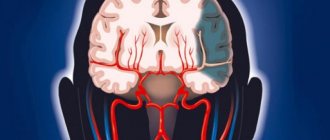Find out more about other diseases starting with the letter “E”: Extramedullary tumors of the spinal cord; Encephalitis; Rasmussen's encephalitis; Encephalitis St. Louis; Encephalopathy; Hashimoto's encephalopathy; Ependymoma of the brain; Ependymoma of the spinal cord; Epidural hematoma; Epilepsy; Epilepsy in pregnant women; Status epilepticus; Erythromelalgia; Essential tremor; Esthesioneuroblastoma; Echinococcosis of the brain.
General concept
Erythromelalgia is a chronic disease, which is represented by paroxysms of a specifically located painful sensation of a burning nature and rapid deformation of the color of the skin. The painful condition usually forms in the area of the lower extremities (feet) or, much less frequently, in the upper extremities (damage to the hands), the area of the ear canals, and nose. The anomaly has two stages: primary and secondary. As diagnostic techniques, medical staff resort to studying the standard clinical picture of an attack, conducting laboratory tests, radiography, thermography, computed tomography, magnetic resonance examination, and electrophysiological testing.
An integrated therapeutic approach, including the use of pharmacological drugs for vasoconstriction, antihistamine and anti-inflammatory drugs, helps to get rid of the symptoms of the disorder. In addition, it prescribes acupuncture sessions and physiotherapeutic procedures.
Causes of the disease
The true cause of the progression of erythromelalgia has not yet been established. But scientists already know for sure that this disease can manifest itself both initially and as a consequence of other pathologies. In this case, erythromelalgia is secondary. Most often, the disease manifests itself against the background of the following conditions:
- myxedema;
- blood pathologies;
- syringomyelia;
- alcoholism;
- diabetes;
- multiple sclerosis;
- endarteritis;
- gout;
- phlebitis;
- osteochondrosis of the spinal column with pronounced symptoms;
- tabes dorsalis;
- trauma of varying severity.
Primary erythromelalgia is severe and requires long-term treatment. Symptoms of pathology are expressed very intensely. Secondary erythromelalgia has a calmer and more favorable course. It responds well to treatment.
Brief information
The first mention of erythromelalgia appeared in the mid-19th century during observations of soldiers who had previously suffered injuries. In those years, the attacks of the disease were given names - post-traumatic hyperesthesia. However, after a while, the American surgeon Mitchell, while monitoring victims of combat, identified similar manifestations. Scientists gave a modern name to the disease, which became the most successful and is still used by doctors to this day.
When translated from Latin, “erythros” means “red,” “melos” means “limb,” and “algos” means “pain,” which reliably describes all the symptoms of the anomaly. Sometimes, in the medical literature you can find Mitchell's disease.
Limb damage is a fairly rare disorder. It belongs to the group of angiotrophoneuroses - lesions of the peripheral blood circulation, which are interconnected with problems of innervation of the vascular sections. Deviation from the norm is usually of local origin with the addition of one or two feet. There is a possibility that the disorder will be transferred to the hands. Doctors report that they often diagnose the disorder in the middle-aged population (30-50 years old) or in childhood - in isolated situations. The painful condition is presented without gender distinction.
Main sources of occurrence
The etiological origin of erythromelalgia is still under investigation. However, doctors say that the basis of the disorder is an abnormality in the nervous regulation of the choroid. A consequence of the failure of the stable functioning of the vasomotor system is the formation of local dilatation in the peripheral part of small and medium-sized vessels. As a result, the patient experiences a restructuring of blood flow towards an increase in the influx of blood cells of an arterial nature. The patient's clinical history shows redness.
Vascular dilation is combined with an increased level of permeability of the cavities, which ultimately provokes the formation of swelling. According to tests, the formation of pain is caused by the release of humoral particles and overirritation of the sympathetic departments. To date, medical staff have not been able to determine the degree of damage to the nervous system due to which the disease is formed. In some cases, abnormal abnormalities occurring in the posterior spinal cord, peripheral nerve roots, and trunks have been reported. Primary erythromelalgia refers to an independent lesion. The secondary form can occur with impaired functioning of the spinal cord, blood diseases, alcohol abuse, endocrine defects, abnormal metabolism, and vibration abnormalities.
Diagnostics
It will not be difficult for an experienced specialist to recognize the pathology, as it has a characteristic clinical picture. Diagnosis of pathology includes the following activities:
- examination and interview of the patient. It is important for the specialist to clarify when the signs of the disease first appeared, how intense they are, whether they are related to the influence of certain factors, etc.;
- taking blood for biochemical and clinical analysis;
- clinical analysis of urine;
- radiography;
- Ultrasound;
- CT and MRI (to identify concomitant pathologies that could provoke erythromelalgia).
Symptoms
Doctors consider the classic attack of an erythromelalgic nature to be the main manifestations of neurological damage. The patient develops burning or baking painful sensations, which are accompanied by intense formation of red spots and swelling. Patients are initially diagnosed with symptoms in the area of the big toe. Subsequently, the lesion spreads to the entire area of the foot and the second limb. The pain syndrome can appear on both legs at the same time (even the hand is susceptible to infection). Quite rarely, deformations in the color of the skin layer can be seen in the area of the nose, ear canals, genitals or on the chest (in females).
The painful sensations reach a powerful degree, as a result the patient is unable to move during the paroxysm. Seizures are caused by overheating, hanging limbs, or squeezing. Sometimes, deviation can occur after wrapping and squeezing the legs with a blanket. The average duration of an erythromelalgic attack ranges from three minutes to several hours. The symptoms of the anomaly can be eliminated by warming the affected area, walking and squeezing sudden pain. The use of cold helps reduce the intensity of the attack. In an elevated position, the patient experiences a period of relief, as the level of influx of blood cells decreases. Deviation from the norm is distinguished by a chronic form of persistent course. During the warm season, the number of dangerous attacks increases significantly.
During the onset of the interparxismal stage, deformations of the vascular and trophic plane are noticed in the inflammatory area. Blueness develops and the degree of moisture saturation of the skin decreases, brittle nails appear, and there is a possibility of the formation of ulcerative elements. The swelling is permanent. Doctors diagnose paresthesia, high levels of sensory activity, or changes in sensory perception.
Depending on the stage of the disease, we choose one or more treatment methods:
Osteopathy
Soft technique of working with the spine, joints, muscles, ligaments, internal organs. Eliminates pain and starts the self-healing process.
Acupuncture
Work on biologically active points. It affects the affected area and the body as a whole. Eliminates the cause of the disease and removes the symptoms.
Massotherapy
Returns elasticity to ligaments and muscles, restores strength and tone, removes “clamps”, improves blood circulation, speeds up metabolism, relieves swelling.
In addition, according to indications, the following are used: hirudotherapy (according to indications), cupping massages and other methods. The choice of procedures depends on the current condition; taken together, they act faster and give a more lasting result.
How is erythromelalgia diagnosed?
If a standard clinical history is present, the neurologist can easily give a correct conclusion to the patient. It is worth paying attention to differential diagnostics to exclude the presence of other similar anomalies. Detection of sympathalgia is considered the main distinguishing feature of Mitchell's disease from acroerythroses. The latter lesion appears in damp and cold climates, and the described disorder consistently reduces the level of damage in cool weather. As diagnostic procedures, doctors resort to the following methods:
- Thermography.
- X-ray examination of the foot.
- Doppler ultrasound of vascular sections.
- Capillaroscopy.
- Magnetic resonance scanning of the lumbar spine.
- Ultrasound examination of the nerve.
- Electroneuromyography.
- Based on the indications, computed tomography or MRI testing of the foot is prescribed.
- Collection of blood cells for biochemical analysis.
- Assessment of the level of cortisol and hormonal elements in the thyroid gland.
If endocrinological abnormalities are detected, the patient will need to visit an endocrinologist's office, and if vascular abnormalities are detected, a consultation with a phlebologist or surgeon is needed.
Treatment options
The patient is prescribed a comprehensive course of therapy using pharmacological medications and physiotherapeutic techniques. Due to the fact that with erythromelalgia the main problem is the dilation of blood vessels, during an attack, means are used to narrow them. However, the doctor should prescribe such substances with caution, since their use is associated with the possibility of arterial disorders. To get rid of edema, antihistamines are needed. NSAIDs are suitable for pain relief.
The complex treatment course includes drugs that increase the strength of the walls of blood vessels. During the interparoxysmal stage, it is recommended to undergo reflexology sessions, take mud, hand and foot baths, and visit radon and carbon dioxide sources. In case of severe and poorly controlled symptoms, surgical intervention is prescribed. The doctor performs a symptaecotomy - elimination of the sympathetic sections that provoke innervation of the affected area. The operation does not eliminate the presence of attacks, but it helps relieve pain.
Further prognosis and preventive measures
Erythromelalgia is not a life-threatening lesion of the body, but the prognosis with proper treatment remains questionable. A high level of favorable course occurs in the secondary stage, when the patient gets rid of the causative factor. The primary form is distinguished by a more severe and developing course, provoking an expansion of the abnormal area of deformation and the frequency of paroxysms. There are cases of independent recovery of the patient. Preventive measures consist of following these rules:
- Getting rid of intense physical activity.
- Avoiding overheating.
- Stop using inappropriate shoes that restrict movement.
- In the case of work associated with constant muscle strain, staying in fairly hot rooms, the patient will need to change the scope of activity.
Preventive measures
Carrying out preventive measures is problematic because the exact causes of the disease are not known. In order to reduce possible risks, several rules should be followed:
- avoid places where the temperature is very high, this applies to visiting saunas and baths, as well as countries with a hot climate;
- get rid of bad habits;
- avoid work that causes muscle strain and increased blood circulation;
- Avoid injuries and frostbite to hands and feet.
Erythromelalgia is rare, but it is not yet possible to clearly define the risk group, so the best way to avoid this disease is to maintain a healthy lifestyle and be attentive to your body, allowing you to notice the first symptoms of an unusual disease.











